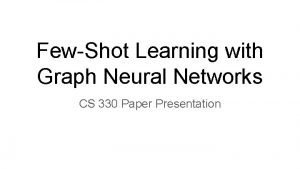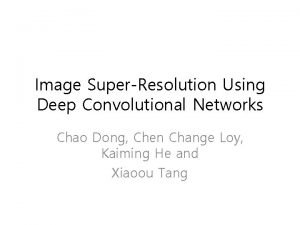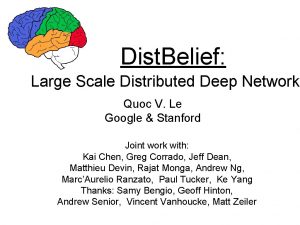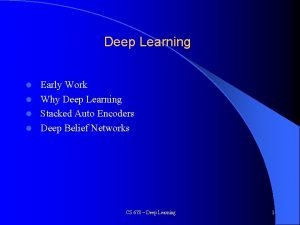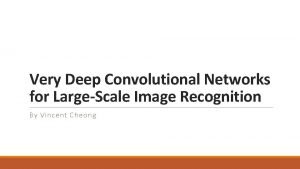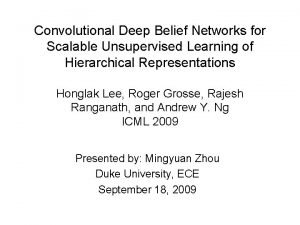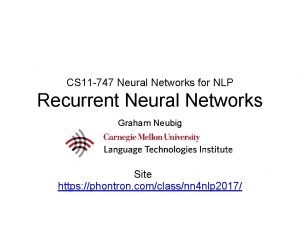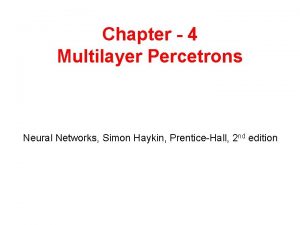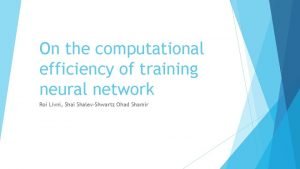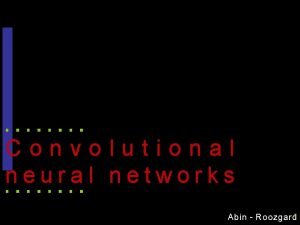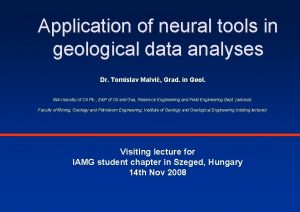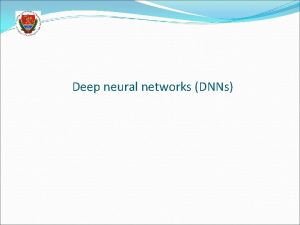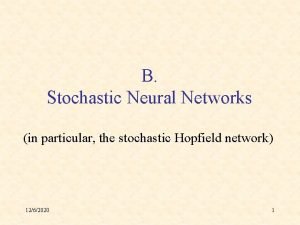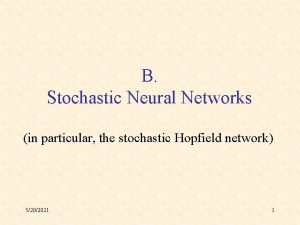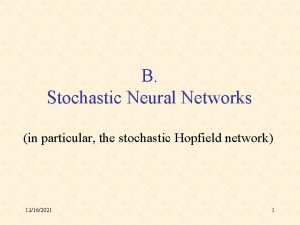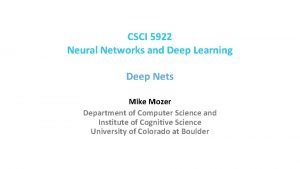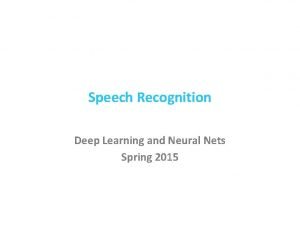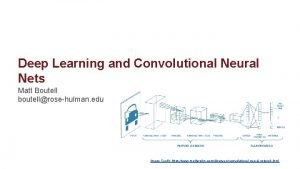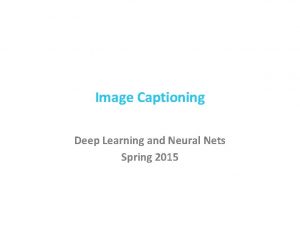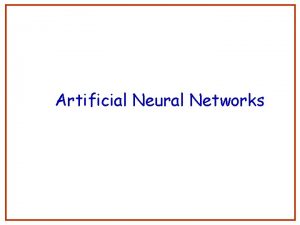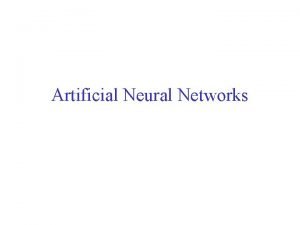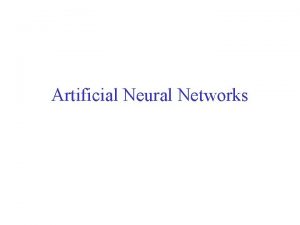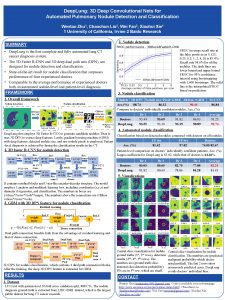Stochastic Neural Networks Deep Learning and Neural Nets





































- Slides: 37

Stochastic Neural Networks Deep Learning and Neural Nets Spring 2015

Neural Net T-Shirts

Neural Net T-Shirts

Neural Net T-Shirts

Neural Net T-Shirts

Neural Net T-Shirts

A Brief History Of Deterministic And Stochastic Networks Boltzmann Machines / Harmony Nets 1985 1982 Hopfield Nets 1986 Back Propagation 1992 Sigmoid Belief Networks 2009 2005 Deep Restricted Boltzmann Learning With Machines Back and Propagation Deep Belief Nets





Hopfield Networks ü ü Binary-threshold units Asynchronous update Symmetric weights Solves an optimization problem § minimize energy (or cost or potential) § maximize harmony (or goodness-of-fit) § search for parameters (activities) that produce the best solution

y h


Hopfield Net As Content Addressible Memory ü Won’t discuss training procedure because it’s dorky § Hebbian learning ü ü Training on set of patterns causes them to become attractors Degraded input is mapped to nearest attractor


Boltzmann Machine Demo ü Necker Cube Demo (Simon Dennis)

How a Boltzmann machine models data •

Three Ways To Specify Inputs ü Use input to set initial activations § bad idea: initial activations irrelevant once equilibrium is reached ü Use input to clamp or freeze unit activations § clamped neurons effectively vanish from network and serve as bias on hidden neurons ü Use input to impose strong bias § set bi such that unit i will (almost) always be off or on




Back To Thermal Equilibrium



ü Positive and negative phases § positive phase clamp visible units set hidden randomly run to equilibrium for given T compute expectations <oioj>+ § negative phase set visible and hidden randomly run to equilibrium for T=1 compute expectations <oioj> no need for back propagation

Why Boltzmann Machine Failed ü Too slow § loop over training epochs loop over training examples loop over 2 phases (+ and -) loop over annealing schedule for T loop until thermal equilibrium reached loop to sample <oioj> ü ü Sensitivity to annealing schedule Difficulty determining when equilibrium is reached As learning progresses, weights get larger, energy barriers get hard to break -> becomes even slower Back prop was invented shortly after § The need to perform pattern completion wasn’t necessary for most problems (feedforward nets sufficed)

Comments On Boltzmann Machine Learning Algorithm ü No need for back propagation § reaching thermal equilibrium involves propagating information through network ü Positive and negative phase § positive phase clamp visible units set hidden randomly run to equilibrium for T=1 compute expectations <oioj>+ § negative phase set visible and hidden randomly run to equilibrium for T=1 compute expectations <oioj> Why Boltzmann machine failed (circa 1985)

Restricted Boltzmann Machine (also known as Harmony Network) ü ü Architecture Why positive phase is trivial Contrastive divergence algorithm Example of RBM learning

RBM Generative Model As A Product Of Experts

Deep RBM Autoencoder Hinton & Salakhutdinov (2006)




Deep Belief Nets (DBNs): Using Stacked RBMs As A Generative Model H 3 H 2 H 2 H 1 H 1 V V ü ü Generative model is not a Boltzmann machine Why do we need symmetric connections between H 2 and H 3?

Using A DBN For Supervised Learning ü ü 1. Train RBMs in unsupervised fashion H 1 H 2 H 3 V H 1 H 2 2. In final RBM, include additional units representing class labels H 4 L ü H 3 3 a. Recognition model § Use feedforward weights and fine tune with back prop ü 3 b. Generative model § Alternating Gibbs sampling between H 3 and H 4, and feedback weights elsewhere L L H 4 H 3 H 2 H 1 V V

Performance on MNIST (Hinton, Osindero, & Teh, 2006) recognition model generative model
 Deep forest: towards an alternative to deep neural networks
Deep forest: towards an alternative to deep neural networks Deep neural networks and mixed integer linear optimization
Deep neural networks and mixed integer linear optimization Efficient processing of deep neural networks pdf
Efficient processing of deep neural networks pdf Neural networks and learning machines 3rd edition
Neural networks and learning machines 3rd edition Neural networks and learning machines
Neural networks and learning machines Few shot learning with graph neural networks
Few shot learning with graph neural networks Tony wagner's seven survival skills
Tony wagner's seven survival skills Deep learning vs machine learning
Deep learning vs machine learning Visualizing and understanding convolutional neural networks
Visualizing and understanding convolutional neural networks Neural networks for rf and microwave design
Neural networks for rf and microwave design Neural networks and fuzzy logic
Neural networks and fuzzy logic Virtual circuit and datagram networks
Virtual circuit and datagram networks Deep asleep deep asleep it lies
Deep asleep deep asleep it lies 深哉深哉耶穌的愛
深哉深哉耶穌的愛 Image super-resolution using deep convolutional networks
Image super-resolution using deep convolutional networks Neural language model
Neural language model Greedy layer wise training of deep networks
Greedy layer wise training of deep networks Deep convolutional networks
Deep convolutional networks Convolutional deep belief networks
Convolutional deep belief networks Liran szlak
Liran szlak Neuroplasticity ib psychology
Neuroplasticity ib psychology Audio super resolution using neural networks
Audio super resolution using neural networks Convolutional neural networks for visual recognition
Convolutional neural networks for visual recognition Style transfer
Style transfer Stride in cnn
Stride in cnn Pixel rnn
Pixel rnn Matlab neural network toolbox
Matlab neural network toolbox 11-747 neural networks for nlp
11-747 neural networks for nlp Xor problem
Xor problem Csrmm
Csrmm On the computational efficiency of training neural networks
On the computational efficiency of training neural networks Input layer
Input layer Introduction to convolutional neural networks
Introduction to convolutional neural networks Lmu cis
Lmu cis Convolutional neural networks
Convolutional neural networks Neuraltools neural networks
Neuraltools neural networks Rnn andrew ng
Rnn andrew ng Predicting nba games using neural networks
Predicting nba games using neural networks





